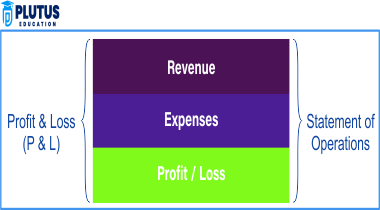The profit and loss account is the most sensitive financial statement that provides a background for understanding one’s performance over a certain period. It shows how much revenue one earns, how much expenses one incurs, and what the net profit or net loss is, hence revealing whether or not a business activity pays off. Below is the discussion on the format, preparation of this account, and breakdown of each element in depth.
What is Profit & Loss Statement?
A profit and loss statement, or an income statement, is a document that reports revenues, costs, and expenses for a given period. It is applied in all kinds of businesses, from tiny one-man bands to large corporations. They use it to keep in touch with their profitability, check the present health of their finances, or make informed business decisions.
One of the three major financial statements is the profit and loss account. The balance sheet and the cash flow statement are the other two. In short, it links revenues to expenses resulting in net profit or net loss.
How to Prepare a Profit & Loss Statement?
A profit and loss statement is prepared by systematically recording income and expenses to derive either net profit or loss. The preparation may vary slightly depending upon the kind of organization—sole trader, partnership, or corporation—and the industry.
Record All Income:
- List all income sources like sales revenue, service income, or other operating revenue.
- Non-operating income, such as interest or rental income, is recorded separately.
List All Expenses:
- Operating expenses like salaries, rent, and cost of goods sold are recorded.
- Non-operating expenses, like interest expenses or one-time costs, are also noted.
Calculate Gross Profit:
- Gross Profit = Sales Revenue – Cost of Goods Sold (COGS).
- COGS includes direct costs like materials, labor, and overheads related to production.
Calculate Net Profit/Loss:
- Net Profit/Loss = Gross Profit – Total Expenses.
- This final figure reveals the company’s profitability or loss.

Profit and Loss Account Format
The format of a profit and loss account does differ slightly from the nature of business, especially between sole traders, partnership firms, and companies. In the next few sub-accounts, we look at specific formats for each type.
Format for Sole Traders & Partnership Firms
Sole traders and partnerships have simpler structures in their P&L account format. This structure generally includes the primary revenue and expense categories without complex itemizations.
Profit & Loss Account Format for Sole Traders and Partnership Firms
| Particulars | Amount (₹) |
|---|---|
| Income | |
| Sales Revenue | |
| Other Income | |
| Total Income | |
| Less: Expenses | |
| Cost of Goods Sold (COGS) | |
| Salaries and Wages | |
| Rent and Utilities | |
| Depreciation | |
| Miscellaneous Expenses | |
| Total Expenses | |
| Net Profit/Loss |
This format gives sole traders and partnerships an effective way to organize their revenues and costs, enabling them to assess overall profitability.
Format of P&L Account for Companies
Companies are relatively large in structure and follow various enactments, like the Companies Act of 2013. For this purpose, more elaborative formats are followed by companies. Here is a general format of corporate profit and loss accounts:
Format of Profit & Loss Account for Companies
| Particulars | Note | Amount (₹) |
|---|---|---|
| Revenue from Operations | ||
| Other Income | ||
| Total Revenue | ||
| Expenses | ||
| Cost of Goods Sold | ||
| Employee Benefit Expenses | ||
| Finance Costs | ||
| Depreciation and Amortization | ||
| Other Expenses | ||
| Total Expenses | ||
| Profit Before Tax | ||
| Tax Expense | ||
| – Current Tax | ||
| – Deferred Tax | ||
| Profit for the Period |
This structure complies with accounting standards and includes key sections like revenue, expenses, and tax implications, which align with regulatory standards.
Components of Profit & Loss Statement
Understanding the components of the profit and loss statement helps clarify each element’s role in calculating net profit or loss.
1. Revenue: Revenue from operations is the bottom-line income resulting from the sale or service-oriented business activities of a firm. To a firm, it is extremely important to differentiate between operating income and other incomes like investment gains, which are shown under non-operating income.
2. Cost of Goods Sold (COGS): COGS stands for the direct costs associated with producing goods or offering services. For a manufacturing concern, this would be raw materials and labor directly used in the production process.
3. Gross Profit: Gross profit is obtained by subtracting COGS from revenues. This measures the firm’s profitability at the first cost of production level minus other operating expenses.
4. Operating Costs: Operating costs refer to running costs incurred by a business enterprise, such as rent and utilities, salary, and administrative costs.
5. Finance Costs: Finance cost refers to interest paid on loans and other forms of financial obligations. Reducing finance costs will be the way to ensure profitable operations.
6. Depreciation and Amortization: Depreciation is the decrease in the value of any tangible asset, whereas amortization is for intangible assets. All these are non-cash charges and decrease the net income. It is a real concept since it expresses actual time passing about the depreciation of assets.
7. Tax Expense: Tax expenses arise from profit before tax, and these companies depict both current and deferred taxes. The depiction increases its success in tax planning and compliance.
8. Net Profit/Loss: The last number in a profit and loss statement is net profit (or net loss), the residual amount available to shareholders or for re-investment in the business.
A well-prepared profit and loss account provides invaluable insights into the health and performance of a business. By knowing the format of the profit and loss account, the purpose behind each line item, and the significance of each category, it is possible to maintain a clear financial record in all types of businesses, from sole traders to corporations. The analysis of this document can be very useful for businesses to make proper decisions toward the optimization of their business operations and planning for sustainable growth.
Profit and Loss Account Format FAQs
What is the purpose of a profit and loss account?
The profit and loss account provides insights into a company’s financial performance, showing income versus expenses, and helps stakeholders understand profitability.
What is the difference between revenue and income?
Revenue is the total earnings from operations, while income often refers to net earnings after expenses.
How does a profit and loss account differ for companies and sole traders?
Companies follow a more detailed format that includes mandatory line items per accounting standards, while sole traders have simpler structures with fewer specific requirements.
Why are depreciation and amortization included in the P&L account?
They represent the gradual reduction in asset value, helping reflect true business expenses and profitability.
What are finance costs in a profit and loss account?
Finance costs include interest and other costs related to borrowing, which impact net profit and provide insight into a company’s financial health.


